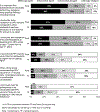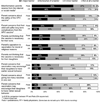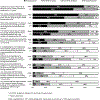HPV Vaccine Delivery Practices by Primary Care Physicians
- PMID: 31527175
- PMCID: PMC8297056
- DOI: 10.1542/peds.2019-1475
HPV Vaccine Delivery Practices by Primary Care Physicians
Abstract
Background and objectives: To examine, among pediatricians and family physicians (FPs) (1) human papillomavirus (HPV) vaccine delivery practices, (2) delivery experiences, and (3) attitudes regarding new 2-dose HPV vaccination schedules.
Methods: We surveyed nationally representative networks of pediatricians and FPs by Internet or mail from July 2018 to September 2018. Multivariable regression was used to assess factors associated with refusal or deferral rates of ≥50% among 11- to 12-year-old patients.
Results: The response rate was 65% (302 pediatricians and 228 FPs included). Pediatricians who strongly recommended the HPV vaccine ranged from 99% for patients ≥15 years old (female) to 83% for those 11 to 12 years old (male); FPs ranged from 90% for patients ≥15 years old (female) to 66% for those 11 to 12 years old (male) (P < .0001 between specialties). Sixty-five percent of pediatricians and 42% of FPs always or almost always used presumptive style when discussing the HPV vaccine (P < .0001). Overall, 40% used standing orders and 42% had electronic alerts. Among pediatricians, the proportion reporting a refusal or deferral rate ≥50% was 19% for female patients and 23% for male patients 11 to 12 years old; FPs reported 27% and 36%, respectively. In the multivariable regression (both sexes), refusal or deferral was associated with physicians not strongly recommending the HPV vaccine to 11- to 12-year-old patients, not using a presumptive style, perceiving less resistance when introducing the HPV vaccine to a 13-year-old patient versus an 11- or 12-year-old patient, and anticipating an uncomfortable conversation when recommending the HPV vaccine to an 11- or 12-year-old patient. Eighty-nine percent of pediatricians and 79% of FPs reported that more adolescents <15 years old are completing the HPV series now that only 2 doses are recommended.
Conclusions: Although most physicians strongly recommend the HPV vaccine to 11- to 12-year-old patients, our data reveal areas for improvement in recommendation and delivery methods. Most physicians perceive that the 2-dose schedule is resulting in higher HPV completion rates.
Copyright © 2019 by the American Academy of Pediatrics.
Conflict of interest statement
POTENTIAL CONFLICT OF INTEREST: The authors have indicated they have no potential conflicts of interest to disclose.
Figures






References
-
- Zandberg DP, Bhargava R, Badin S, Cullen KJ. The role of human papillomavirus in nongenital cancers. CA: a cancer journal for clinicians. 2013;63(1):57–81. - PubMed
-
- Parkin DM, Bray F. Chapter 2: The burden of HPV-related cancers. Vaccine. 2006;24 Suppl 3:S3/11–25. - PubMed
-
- Centers for Disease Control and Prevention. How Many Cancers Are Linked with HPV Each Year? HPV and Cancer 2018; https://www.cdc.gov/cancer/hpv/statistics/cases.htm. Accessed April 3, 2019.
Publication types
MeSH terms
Substances
Grants and funding
LinkOut - more resources
Full Text Sources
Miscellaneous

